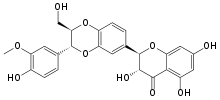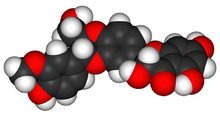Silibinin
 | |
 | |
| Systematic (IUPAC) name | |
|---|---|
|
(2R,3R)-3,5,7-trihydroxy- 2-[(2R,3R)-3-(4-hydroxy-3-methoxyphenyl)-2-(hydroxymethyl) -2,3-dihydrobenzo[b][1,4]dioxin-6-yl]chroman-4-one | |
| Clinical data | |
| AHFS/Drugs.com | International Drug Names |
| Oral Intravenous | |
| Identifiers | |
|
22888-70-6 | |
| A05BA03 | |
| PubChem | CID 31553 |
| ChemSpider |
29263 |
| UNII |
4RKY41TBTF |
| KEGG |
D08515 |
| ChEBI |
CHEBI:9144 |
| ChEMBL |
CHEMBL9509 |
| Chemical data | |
| Formula | C25H22O10 |
| 482.44 g/mol | |
|
SMILES
| |
| |
| | |
Silibinin (INN), also known as silybin (both from Silybum, the generic name of the plant from which it is extracted), is the major active constituent of silymarin, a standardized extract of the milk thistle seeds, containing a mixture of flavonolignans consisting of silibinin, isosilibinin, silicristin, silidianin and others. Silibinin itself is mixture of two diastereomers, silybin A and silybin B, in approximately equimolar ratio.[1] Both in vitro and animal research suggest that silibinin has hepatoprotective (antihepatotoxic) properties that protect liver cells against toxins.[2][3] Silibinin has also demonstrated in vitro anti-cancer effects against human prostate adenocarcinoma cells, estrogen-dependent and -independent human breast carcinoma cells, human ectocervical carcinoma cells, human colon cancer cells, and both small and nonsmall human lung carcinoma cells.[4][5][6][7]
Chemically modified silibinin, silibinin dihydrogen disuccinate disodium (trade name Legalon SIL), a solution for injection, is currently being tested as a treatment of severe intoxications with hepatotoxic substances, such as death cap (Amanita phalloides) poisoning.[8] There is also clinical evidence for the use of silibinin as a supportive element in alcoholic and child grade 'A' liver cirrhosis.[9]
Pharmacology
Poor water solubility and bioavailability of silymarin led to the development of enhanced formulations. Silipide (trade name Siliphos), a complex of silymarin and phosphatidylcholine (lecithin), is about 10 times more bioavailable than silymarin.[10] An earlier study had concluded Siliphos to have 4.6 fold higher bioavailability.[11] It has been also reported that silymarin inclusion complex with β-cyclodextrin is much more soluble than silymarin itself.[12] There have also been prepared glycosides of silybin, which show better water solubility and even stronger hepatoprotective effect.[13] Silibinin has been reported to exert a neuroprotective effect in mice.[14]
Silymarin is the first ingredient in several products sold as herbal telomerase activators, though the research demonstrating silymarin's effectiveness in this regard is proprietary and unpublished.
Silymarin, as other flavonoids, has been shown to inhibit P-glycoprotein-mediated cellular efflux.[15] The modulation of P-glycoprotein activity may result in altered absorption and bioavailability of drugs that are P-glycoprotein substrates. It has been reported that silymarin inhibits cytochrome P450 enzymes and an interaction with drugs primarily cleared by P450s cannot be excluded.[16]
Toxicity
A phase I clinical trial in humans with prostate cancer designed to study the effects of high dose silibinin found 13 grams daily to be well tolerated in patients with advanced prostate cancer with asymptomatic liver toxicity (hyperbilirubinemia and elevation of alanine aminotransferase) being the most commonly seen adverse event.[17]
The compound is also devoid of embryotoxic potential in animal models.[18][19]
Potential medical uses
A recent study suggested that silymarin may help patients with type II diabetes by assisting in blood sugar control.[20]
Lab experiments on mice showed that silibinin protects the hepatic cells against the toxin alpha-amanitin which causes Amanita phalloides mushroom poisoning.
Biotechnology
Silymarin can be produced in callus and cells suspensions of Silybum marianum and substituted pyrazinecarboxamides can be used as abiotic elicitors of flavolignan production.[21]
See also
- Sulfad, a drug containing silibinin.
References
- ↑ Davis-Searles P, Nakanishi, Y, Nam-Cheol K, et al. (2005). "Milk Thistle and Prostate Cancer: Differential Effects of Pure Flavonolignans from Silybum marianum on Antiproliferative End Points in Human Prostate Carcinoma Cells" Cancer Research 65 (10):4448-57. doi:10.1158/0008-5472.CAN-04-4662
- ↑ Al-Anati L, Essid E, Reinehr R, Petzinger E (2009). "Silibinin protects OTA-mediated TNF-alpha release from perfused rat livers and isolated rat Kupffer cells". Molecular Nutrition & Food Research 53 (4): 460–6. doi:10.1002/mnfr.200800110. PMID 19156713.
- ↑ Jayaraj R, Deb U, Bhaskar AS, Prasad GB, Rao PV (2007). "Hepatoprotective efficacy of certain flavonoids against microcystin induced toxicity in mice". Environmental Toxicology 22 (5): 472–9. doi:10.1002/tox.20283. PMID 17696131.
- ↑ Mokhtari MJ, Motamed N, Shokrgozar MA (2008). "Evaluation of silibinin on the viability, migration and adhesion of the human prostate adenocarcinoma (PC-3) cell line". Cell Biology International 32 (8): 888–92. doi:10.1016/j.cellbi.2008.03.019. PMID 18538589.
- ↑ Bhatia N, Zhao J, Wolf DM, Agarwal R (1999). "Inhibition of human carcinoma cell growth and DNA synthesis by silibinin, an active constituent of milk thistle: comparison with silymarin". Cancer Letters 147 (1–2): 77–84. doi:10.1016/S0304-3835(99)00276-1. PMID 10660092.
- ↑ Hogan FS, Krishnegowda NK, Mikhailova M, Kahlenberg MS (2007). "Flavonoid, silibinin, inhibits proliferation and promotes cell-cycle arrest of human colon cancer". Journal of Surgical Research 143 (1): 58–65. doi:10.1016/j.jss.2007.03.080. PMID 17950073.
- ↑ Sharma G, Singh RP, Chan DC, Agarwal R (2003). "Silibinin induces growth inhibition and apoptotic cell death in human lung carcinoma cells". Anticancer Research 23 (3B): 2649–55. PMID 12894553.
- ↑ Mitchell, T (2009). "Intravenous Milk thistle (silibinin-legalon) for hepatic failure induced by amatoxin/Amanita mushroom poisoning". (Clinical study).
- ↑ Saller R, Brignoli R, Melzer J, Meier R (2008). "An updated systematic review with meta-analysis for the clinical evidence of silymarin". Forschende Komplementärmedizin (2006) 15 (1): 9–20. doi:10.1159/000113648. PMID 18334810. Retrieved 2010-12-14.
- ↑ Kidd P, Head K (2005). "A review of the bioavailability and clinical efficacy of milk thistle phytosome: a silybin-phosphatidylcholine complex (Siliphos)". Alternative Medicine Review : a Journal of Clinical Therapeutic 10 (3): 193–203. PMID 16164374. Retrieved 2010-12-14.
- ↑ Barzaghi N, Crema F, Gatti G, Pifferi G, Perucca E. Eur J Drug Metab Pharmacokinet 1990;15:333–8.
- ↑ Voinovich D, Perissutti B, Grassi M, Passerini N, Bigotto A (2009). "Solid state mechanochemical activation of Silybum marianum dry extract with betacyclodextrins: Characterization and bioavailability of the coground systems". Journal of Pharmaceutical Sciences 98 (11): 4119–29. doi:10.1002/jps.21704. PMID 19226635.
- ↑ Kosina P, Kren V, Gebhardt R, Grambal F, Ulrichová J, Walterová D (2002). "Antioxidant properties of silybin glycosides". Phytotherapy Research : PTR. 16 Suppl 1: S33–9. doi:10.1002/ptr.796. PMID 11933137.
- ↑ Tota, S; Kamat, PK; Shukla, R; Nath, C (2011). "Improvement of brain energy metabolism and cholinergic functions contributes to the beneficial effects of silibinin against streptozotocin induced memory impairment". Behavioural Brain Research 221 (1): 207–15. doi:10.1016/j.bbr.2011.02.041. PMID 21382422.
- ↑ Zhou S, Lim LY, Chowbay B (2004). "Herbal modulation of P-glycoprotein". Drug Metabolism Reviews 36 (1): 57–104. doi:10.1081/DMR-120028427. PMID 15072439.
- ↑ Wu JW, Lin LC, Tsai TH (2009). "Drug-drug interactions of silymarin on the perspective of pharmacokinetics". Journal of Ethnopharmacology 121 (2): 185–93. doi:10.1016/j.jep.2008.10.036. PMID 19041708. Retrieved 2010-12-14.
- ↑ Thomas W. Flaig, Daniel L. Gustafson, Lih-Jen Su, Joseph A. Zirrolli, Frances Crighton, Gail S. Harrison, A. Scott Pierson, Rajesh Agarwal, L. Michael Glodé (2007). "A phase I and pharmacokinetic study of silybin-phytosome in prostate cancer patients". Investigational New Drugs 25 (2): 139–146. doi:10.1007/s10637-006-9019-2.
- ↑ Fraschini F, Demartini G, Esposti D (2002). "Pharmacology of Silymarin". Clinical Drug Investigation 22 (1): 51–65. doi:10.2165/00044011-200222010-00007.
- ↑ Hahn G, Lehmann HD, Kürten M, Uebel H, Vogel G (1968). "On the pharmacology and toxicology of silymarin, an antihepatotoxic active principle from Silybum marianum (L.) gaertn". Arzneimittelforschung 18 (6): 698–704. PMID 5755807.
- ↑ Huseini HF, Larijani B, Heshmat R, Fakhrzadeh H, Radjabipour B, Toliat T, Raza M (2006). "The efficacy of Silybum marianum (L.) Gaertn. (silymarin) in the treatment of type II diabetes: a randomized, double-blind, placebo-controlled, clinical trial". Phytotherapy Research 20 (12): 1036–9. doi:10.1002/ptr.1988. PMID 17072885.
- ↑ Substituted Pyrazinecarboxamides as Abiotic Elicitors of Flavolignan Production in Silybum marianum (L.) Gaertn Cultures in Vitro. Lenka Tůmová, Jiří Tůma, Klara Megušar, and Martin Doleža, Molecules, 2010, 15(1), pages 331-340, doi:10.3390/molecules15010331
External links
- Review of the Quality of Evidence for Milk Thistle Use from MayoClinic.com
- Intravenous Milk Thistle Compound Used to Save Victims of Poisonous Mushrooms
- Morazzoni P, Bombardelli E (1994). "Silybum marianum (cardus marianus)". Fitoterapia 66: 3–42.
- Saller R, Meier R, Brignoli R (2001). "The use of silymarin in the treatment of liver diseases". Drugs 61 (14): 2035–63. doi:10.2165/00003495-200161140-00003. PMID 11735632.
- Silymarin at the US National Library of Medicine Medical Subject Headings (MeSH)
| ||||||||||||||||||||||||||||
| ||||||||||||||||||||||